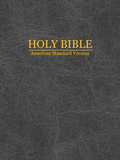American Standard Version of the Holy Bible (1901)
by Anonymous (Bible)
Summary
The American Standard Version (ASV) came into being due to the leadership of eminent church historian Phillip Schaff, who assembled a team comprised of 30 American and British scholars. Work began on the ASV in 1872 and was completed in 1901. The translation committee was tasked with the mission of providing readers with an accurate, literal, word-for-word translation of the Holy Scriptures.
The ASV took advantage of two 19th century developments to achieve their goal: improvements in understanding the grammar and syntax of koine Greek (the language of the New Testament), and a more complete library of manuscripts than previous Bible translators were able to access. The result of this work was a translation that retained distinctions made in Greek that are not normally expressed in modern English language.
For example, second person personal pronouns in modern English usage are normally “you” which provides no distinction between the singular and plural. Koine Greek unambiguously makes the distinction between a second person personal singular pronoun and the second person personal plural pronoun. In this instance committee retained these distinctions by using archaic English (“you” for the singular and “ye” for the plural).
The word-for-word translation of the ASV was attractive in the scholarly environment, and the ASV was adopted as the standard version used by many American seminaries. However, since the committee took less license in translation and retained archaic English usages, the ASV is not as easily readable as other modern versions. As a result, the ASV has not been as successful among lay Christians as it has been in the scholarly community.
Popularity
Available formats
Reviews
